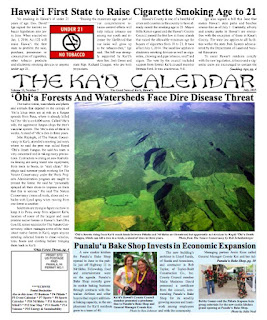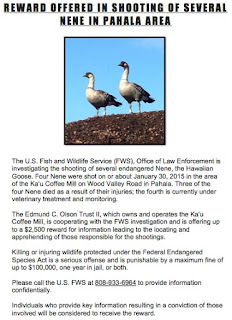 |
| Paniolo of all ages competed in the Fourth of July Rodeo over two days, sponsored by Ka`u Roping & Riding Association. Photo by Julia Neal |
FOURTH OF JULY ALL-AROUND RODEO WINNER earned the champion cowboy belt buckle
yesterday at Na`alehu Rodeo Grounds and proclaimed, “I am not a cowboy!” She is cowgirl Jaymie Loando and wound up with the most points overall competing with kane and wahine. Here is a list of winners during the two-day Fourth of July Rodeo, sponsored by Ka`u Roping & Riding Association:
yesterday at Na`alehu Rodeo Grounds and proclaimed, “I am not a cowboy!” She is cowgirl Jaymie Loando and wound up with the most points overall competing with kane and wahine. Here is a list of winners during the two-day Fourth of July Rodeo, sponsored by Ka`u Roping & Riding Association:
 |
| Roping calves is a required skill on Ka`u ranches. Photo by Julia Neal |
 |
| Jaymie Loando took the All-Around title for the most points at the July 4 rodeo in Na`alehu. Among her winning events was Kane-Wahine Dally with Kelly Medeiros. Photo by Julia Neal |
To comment on or like this story, go to facebook.com/kaucalendar.
HAWAI`I FARM & FOOD is Hawai`i Farm Bureau Federation’s new four-color, glossy magazine. The print and online publication is a media partnership between the statewide Farm Bureau and Pacific Basin Communications, publisher of Hawai`i’s largest magazine group.
“Hawai`i Farm & Food will delve into issues facing Hawai`i’s agricultural industries, unique specialty crops and commodity groups,” said HFBF president Chris Manfredi, of Ka`u Farm and Ranch. “This new magazine will bring the challenges of Hawai`i’s farmers, ranchers and aquaculturists to the forefront to help people better understand how food is produced and brought to store shelves. Think of it as a farm tour you can hold in your hand. We’re particularly excited that the publication’s app will be available for free on iTunes.”
Hawai`i Farm and Food will feature farmers and their stories from across the state, updates on legislative issues, chef highlights of Hawai`i-grown products, recipes and events supporting local agriculture.
See hfbf.org for a current listing. For advertising and sponsorship opportunities, contact Sharon Spear at 808-534-7528 or sharons@pacificbasin.net. To comment on or like this story, go to facebook.com/kaucalendar.
See hfbf.org for a current listing. For advertising and sponsorship opportunities, contact Sharon Spear at 808-534-7528 or sharons@pacificbasin.net. To comment on or like this story, go to facebook.com/kaucalendar.
GOV. DAVID IGE SIGNED FIVE BILLS into law Thursday during bill signing ceremonies at the State Capitol.
HB 1343 (Act 210) appropriates funds to establish a Business Recovery Center within the Department of Defense. The bill appropriates $328,000 in state funding, with a federal match of $1,159,000 for this initiative. The recovery center is an online website where businesses and government agencies collaborate and coordinate information and resources before, during and after a natural disaster.
HB 589 (Act 211) establishes a state stroke data registry and requires hospitals to report stroke patient data. Through this registry, the state’s acute stroke hospitals will collect a uniform data set based on their stroke patients and will submit the date to the state Department of Health. The data will help identify weaknesses in the state’s stroke care system and work to improve the system’s response to and quality care of stroke patients.
HB 467 (Act 212) requires birthing facilities to screen newborns for critical congenital heart defects using pulse oximetry prior to discharging infants from the hospital or birthing center. Pulse oximetry or pulse ox is a simple, non-invasive, inexpensive test in which sensors are placed on the infant’s hand or foot to check blood oxygen levels. The test takes a few minutes, costs under $5 and can identify infants with this defect before symptoms develop. Hawai`i is the 42nd state to require this testing.
HB 589 (Act 211) establishes a state stroke data registry and requires hospitals to report stroke patient data. Through this registry, the state’s acute stroke hospitals will collect a uniform data set based on their stroke patients and will submit the date to the state Department of Health. The data will help identify weaknesses in the state’s stroke care system and work to improve the system’s response to and quality care of stroke patients.
HB 467 (Act 212) requires birthing facilities to screen newborns for critical congenital heart defects using pulse oximetry prior to discharging infants from the hospital or birthing center. Pulse oximetry or pulse ox is a simple, non-invasive, inexpensive test in which sensors are placed on the infant’s hand or foot to check blood oxygen levels. The test takes a few minutes, costs under $5 and can identify infants with this defect before symptoms develop. Hawai`i is the 42nd state to require this testing.
HB 10 (Act 214) authorizes state Department of Education employees to volunteer to be trained to administer and oversee administration of insulin, glucagon or other medication and assist with blood glucose testing if needed. This will improve the ability of diabetic students to manage their diabetes in school and at school-related activities.
To comment on or like this story, go to facebook.com/kaucalendar.
WHAT HAPPENS WHEN EVERYONE has rooftop solar? Life of the Land executive director Henry Curtis asks that question at ililanimedia.blogspot.com.
 |
| Laenaia Andrade took the Youth Barrels buckle. Photo by Julia Neal |
“Ten years ago, virtually no one in Hawai`i had rooftop solar,” Curtis writes. “Today, one is eight electric ratepayers have rooftop solar. Solar prices are dropping. The installation of rooftop solar is escalating.
“Worldwide, solar installations have grown at more than 40 percent per year for more than a decade.
“Three interesting questions arise. One deals with grid parity, the point at which unsubsidized solar is as cheap as electricity from a utility grid.” Grid parity occurs when the cost of solar equals the cost of conventional electricity alternatives without subsidies like feed-in-tariffs, net metering and tax credits.
“This grid parity issue is relevant for Hawai`i,” Curtis writes. “There are many places where grid parity was reached and surpassed. The relative cost of solar depends upon which island one is on, since Neighbor islands have higher utility rates. It depends on whether one is on the windward or leeward side of the island, and how close one is to the mountains. It also depends upon how close the rooftop is to the applicable utility substation.
“A second issue deals with installation costs. The cost of rooftop solar can be broken down into two components: panels and installation. The price of panels has dropped dramatically. The price of installation has remained high. Therefore, installation costs are becoming a larger and larger portion of the total cost.
“Deep Chakraborty wrote a recent blog titled, Why are U.S. Residential Solar Soft Costs So High?
Historically, a person who installs a solar system in Germany filled out a very simply form and received generous rates from the utilities for producing solar electricity.
By contrast, historically, a person who installs a solar system in the United States has to sign a complex net energy metering contract. In addition, ‘unlike Germany, the U.S. needed a whole new cadre of solar integrators with specialized sales teams that can convey complex financing benefits to consumers.’ Governments required complex permits, and sometimes, unnecessary inspections.
“Worldwide, solar installations have grown at more than 40 percent per year for more than a decade.
“Three interesting questions arise. One deals with grid parity, the point at which unsubsidized solar is as cheap as electricity from a utility grid.” Grid parity occurs when the cost of solar equals the cost of conventional electricity alternatives without subsidies like feed-in-tariffs, net metering and tax credits.
 |
| Ayden Benevides won both Goat Undecorating and Dummy Roping in the five-to-eight age group. Photo by Julia Neal |
“A second issue deals with installation costs. The cost of rooftop solar can be broken down into two components: panels and installation. The price of panels has dropped dramatically. The price of installation has remained high. Therefore, installation costs are becoming a larger and larger portion of the total cost.
“Deep Chakraborty wrote a recent blog titled, Why are U.S. Residential Solar Soft Costs So High?
Historically, a person who installs a solar system in Germany filled out a very simply form and received generous rates from the utilities for producing solar electricity.
By contrast, historically, a person who installs a solar system in the United States has to sign a complex net energy metering contract. In addition, ‘unlike Germany, the U.S. needed a whole new cadre of solar integrators with specialized sales teams that can convey complex financing benefits to consumers.’ Governments required complex permits, and sometimes, unnecessary inspections.
“The third interesting issue deals with penetration levels.
 |
| Chance Miranda took the rodeo's Calf Riding title. Photo by Julia Neal |
“During the 1880s, electric trolleys were built throughout the U.S. to absorb excess daytime electricity. But even if we founded new industries that could absorb all of this excessive daytime electricity, where would evening and nighttime electricity come from?
“Most batteries being installed on the electric grid are designed to eliminate fluctuations in solar and wind output. They are designed to flatten the generation output of variable wind and solar generators over a period of seconds to minutes. They do not shift energy from daytime production to evening loads.
“There are a few pumped storage systems which do shift energy between time blocks. They use excess energy to pump water from a lower reservoir to a higher reservoir and then drop the water through hydroelectric generators when the power is needed. There are few such systems in the U.S. and none in Hawai`i.”
“Most batteries being installed on the electric grid are designed to eliminate fluctuations in solar and wind output. They are designed to flatten the generation output of variable wind and solar generators over a period of seconds to minutes. They do not shift energy from daytime production to evening loads.
“There are a few pumped storage systems which do shift energy between time blocks. They use excess energy to pump water from a lower reservoir to a higher reservoir and then drop the water through hydroelectric generators when the power is needed. There are few such systems in the U.S. and none in Hawai`i.”
To comment on or like this story, go to facebook.com/kaucalendar.
HAWAI`I PACIFIC PARKS ASSOCIATION staff share the traditional art of bamboo stamping Wednesday from 10 a.m. to 12 p.m. at Kilauea Visitor Center lanai in Hawai`i Volcanoes National Park. Free; park entrance fees apply.
SUPPORT OUR SPONSORS AT PAHALAPLANTATIONCOTTAGES.COM AND KAUCOFFEEMILL.COM. KA`U COFFEE MILL IS OPEN SEVEN DAYS A WEEK.
 |
| See kaucalendar.com/Directory2015.swf and kaucalendar.com/Directory2015.pdf. |
 |
| See kaucalendar.com/KauCalendar_July2015.pdf. |





